|
Dasychira Mendosa
''Olene mendosa'', the brown tussock moth or hairy tussock moth, is a moth of the family Erebidae. The species was first described by Jacob Hübner in 1823. It is found in India, Bangladesh, Sri Lanka, Indonesia, Taiwan, Thailand and Australia. Description Sexes show dimorphism with variable colour morphs. The wingspan of the female is about 46–54 mm, whereas the male's is about 30–40 mm. The adult male has two morphs. The common form is smoke brown with uniformly brown forewings and pale greyish hindwings. In the forewing, black specks and a pale patch outside the subbasal line can be seen. The adult female also has two forms with an areole on each forewing and they lack the white colored portions on forewings which is found on male. The common form has an irregular longitudinal dark brown zone in the center of forewing. The more rare form has pale colours. The underside of the wings are similar in both sexes with less pronounced markings. The full-grown cate ... [...More Info...] [...Related Items...] OR: [Wikipedia] [Google] [Baidu] |
Jacob Hübner
Jacob Hübner (20 June 1761 – 13 September 1826, in Augsburg) was a German entomologist. He was the author of ''Sammlung Europäischer Schmetterlinge'' (1796–1805), a founding work of entomology. Scientific career Hübner was the author of ''Sammlung Europäischer Schmetterlinge'' (1796–1805), a founding work of entomology. He was one of the first specialists to work on the European Lepidoptera. He described many new species, for example ''Sesia bembeciformis'' and ''Euchloe tagis'', many of them common. He also described many new genus, genera. He was a designer and engraver and from 1786 he worked for three years as a designer and engraver at a cotton factory in Ukraine. There he collected butterflies and moths including descriptions and illustrations of some in ''Beiträge zur Geschichte der Schmetterlinge'' (1786–1790) along with other new species from the countryside around his home in Augsburg. Hübner's masterwork "Tentamen" was intended as a discussion document. I ... [...More Info...] [...Related Items...] OR: [Wikipedia] [Google] [Baidu] |
Ricinus Communis
''Ricinus communis'', the castor bean or castor oil plant, is a species of perennial flowering plant in the spurge family, Euphorbiaceae. It is the sole species in the monotypic genus, ''Ricinus'', and subtribe, Ricininae. The evolution of castor and its relation to other species are currently being studied using modern genetic tools. It reproduces with a mixed pollination system which favors selfing by geitonogamy but at the same time can be an out-crosser by anemophily (wind pollination) or entomophily (insect pollination). Its seed is the castor bean, which, despite its name, is not a bean (that is, the seed of many Fabaceae). Castor is indigenous to the southeastern Mediterranean Basin, Eastern Africa, and India, but is widespread throughout tropical regions (and widely grown elsewhere as an ornamental plant). Castor seed is the source of castor oil, which has a wide variety of uses. The seeds contain between 40% and 60% oil that is rich in triglycerides, mainly ricinolei ... [...More Info...] [...Related Items...] OR: [Wikipedia] [Google] [Baidu] |
Saccharum
''Saccharum'' is a genus of tall perennial plants of the broomsedge tribe within the grass family. The genus is widespread across tropical, subtropical, and warm temperate regions in Africa, Eurasia, Australia, the Americas, and assorted oceanic islands. Several species are cultivated and naturalized in areas outside their native habitats.Welker, C. A. D. & H. M. Longhi-Wagner. 2012. The genera ''Eriochrysis'' P. Beauv., ''Imperata'' Cirillo and ''Saccharum'' L. (Poaceae - Andropogoneae - Saccharinae) in the state of Rio Grande do Sul, Brazil. Brazilian Journal of Botany 35(1): 87–105. ''Saccharum'' includes the sugarcanes. They have stout, jointed, fibrous stalks that are generally rich in sugar, and measure two to six m (6 to 19 ft) tall. All sugarcane species interbreed and the major commercial cultivars are complex hybrids. Species , Plants of the World Online accepted the following species: * ''Saccharum alopecuroidum'' (L.) Nutt. - southeastern USA * ''Saccharum ... [...More Info...] [...Related Items...] OR: [Wikipedia] [Google] [Baidu] |
Pelargonium
''Pelargonium'' () is a genus of flowering plants that includes about 280 species of perennials, succulents, and shrubs, commonly called geraniums, pelargoniums, or storksbills. '' Geranium'' is also the botanical name and common name of a separate genus of related plants, also known as cranesbills. Both genera belong to the family Geraniaceae. Carl Linnaeus originally included all the species in one genus, ''Geranium'', and they were later separated into two genera by Charles Louis L'Héritier de Brutelle in 1789. While ''Geranium'' species are mostly temperate herbaceous plants, dying down in winter, ''Pelargonium'' species are evergreen perennials indigenous to warm temperate and tropical regions of the world, with many species in southern Africa. They are drought and heat tolerant, but can tolerate only minor frosts. Some species are extremely popular garden plants, grown as houseplants and bedding plants in temperate regions. They have a long flowering period, with flowers m ... [...More Info...] [...Related Items...] OR: [Wikipedia] [Google] [Baidu] |
Excoecaria
''Excoecaria'' is a plant genus of the family Euphorbiaceae, formally described by Linnaeus in 1759. The genus is native to the Old World Tropics (Africa, southern Asia, northern Australia, and assorted oceanic islands). Etymology Genus name, ''Excoecaria'', is from the Latin word ''excaeco'', which means "to blind" and refers to the sap of the plants that can cause temporary blindness. Toxic latex The milky latex of ''Excoecaria agallocha'', also known as ''Thillai'', milky mangrove, blind-your-eye mangrove and river poison tree, is poisonous. Mangroves of this plant surround the ancient Thillai Chidambaram Temple in Tamil Nadu. Contact with skin can cause irritation and rapid blistering; contact with eyes will result in temporary blindness. It is distributed in the Pichavaram wetlands, near Chidambaram India, in Australia from northern New South Wales, along the northern coastline around to Western Australia.The latex is extremely poisonous. Even dried and powdered leave ... [...More Info...] [...Related Items...] OR: [Wikipedia] [Google] [Baidu] |
Aleurites
''Aleurites'' is a small genus of arborescent flowering plants in the Euphorbiaceae, first described as a genus in 1776. It is native to China, the Indian Subcontinent, Southeast Asia, Papuasia, and Queensland. It is also reportedly naturalized on various islands (Pacific and Indian Oceans, plus the Caribbean) as well as scattered locations in Africa, South America, and Florida. These monoecious, evergreen trees are perennials or semiperennials. These are large trees, tall, with spreading, drooping, and rising branches. The leaves are alternate, lobate, ovate to ovate-lanceolate with minute stipules. They are pubescent on both sides when young, but in a later stage they become glabrous. The inflorescence consists of terminal plumes of small, creamy white, bell-shaped, fragrant flowers, branching from the base. The flowers are usually bisexual, with a solitary pistillate flower at the end of each major axis. The lateral cymes are staminate. There are five or six imbricate petals ... [...More Info...] [...Related Items...] OR: [Wikipedia] [Google] [Baidu] |
Dipterocarpus
'' D. retusus'' in Köhler ''Dipterocarpus'' is a genus of flowering plants and the type genus of family Dipterocarpaceae. ''Dipterocarpus'' is the third-largest and most diverse genus among the Dipterocarpaceae. The species are well known for timber, but less acknowledged for use in traditional herbal medicine. The genus has about 70 species, occurring in South Asia and Southeast Asia, from Sri Lanka and India to the Philippines. It is an important component of dipterocarp forests. Its generic name comes from Greek and means "two-winged fruits". The greatest diversity of ''Dipterocarpus'' species occurs on Borneo, with many endemic to the island. The oldest fossil of the genus, and Dipterocarpaceae, is from the latest Cretaceous (Maastrichtian) Intertrappean Beds of India. Uses The genus is of considerable importance as timber trees, sold under the trade name Keruing, although not as important as ''Shorea'' species. ''D. turbinatus'', gurjan, is a major commercial timber sp ... [...More Info...] [...Related Items...] OR: [Wikipedia] [Google] [Baidu] |
Shorea
Fruit of a ''Shorea'' species ''Shorea'' is a genus of about 196 species of mainly rainforest trees in the family Dipterocarpaceae. The genus is named after Sir John Shore, the governor-general of the British East India Company, 1793–1798. The timber of trees of the genus is sold under the common names lauan, luan, lawaan, meranti, seraya, balau, bangkirai, and Philippine mahogany. Taxonomy ''Shorea'' fossils (linked with the modern sal, ''S. robusta'', which is still a dominant tree species in Indian forests) are known from as early as the Eocene of Gujarat, India. They are identifiable by the amber fossils formed by their Dammar gum, dammar resin. Other fossils include a Miocene-aged fossilized fruit from the same region; this fruit most closely resembles the extant ''Shorea macroptera, S. macroptera'' of the Malay Peninsula. Description ''Shorea'' spp. are native to Southeast Asia, from northern India to Malaysia, Indonesia, and the Philippines. In west Malesia and th ... [...More Info...] [...Related Items...] OR: [Wikipedia] [Google] [Baidu] |
Raphanus
''Raphanus'' (Latin for "radish") is a genus within the flowering plant family Brassicaceae. Carl Linnaeus described three species within the genus: the cultivated radish (''Raphanus sativus''), the wild radish or jointed charlock (''Raphanus raphanistrum''), and the rat-tail radish (''Raphanus caudatus''). Various other species have been proposed (particularly related to the East Asian daikon varieties) and the rat-tail radish is sometimes considered a variety of ''R. sativus'', but no clear consensus has emerged. ''Raphanus'' species grow as annual plant, annual or biennial plants, with a taproot which is much enlarged in the cultivated radish. Unlike many other genera in the family Brassicaceae, ''Raphanus'' has indehiscent fruit that do not split open at maturity to reveal the seeds. The genus is native to Asia, but its members can now be found worldwide. Growing wild, they are regarded as invasive species in many regions. ''Raphanus'' species are used as food plants by the ... [...More Info...] [...Related Items...] OR: [Wikipedia] [Google] [Baidu] |
Terminalia (plant)
''Terminalia'' is a genus of large trees of the flowering plant family Combretaceae, comprising nearly 300 species distributed in tropical regions of the world. The genus name derives from the Latin word ''terminus'', referring to the fact that the leaves appear at the very tips of the shoots. Selected species There are 282 accepted ''Terminalia'' species as of April 2021 according to Plants of the World Online. Selected species include: *'' Terminalia acuminata'' (Fr. Allem.) Eichl. *'' Terminalia albida'' Scott-Elliot *''Terminalia amazonia'' (J.F.Gmel.) Exell – white olive *''Terminalia arbuscula'' Sw. *''Terminalia archipelagi'' Coode *''Terminalia arjuna'' (Roxb. ex DC.) Wight & Arn. – arjuna, koha, white marudah *''Terminalia arostrata'' Ewart & O.B.Davies – crocodile tree *'' Terminalia australis'' Cambess – palo amarillo, tanimbú *''Terminalia avicennioides'' *''Terminalia bellirica'' (Gaertn.) Roxb. – beleric *''Terminalia bialata ... [...More Info...] [...Related Items...] OR: [Wikipedia] [Google] [Baidu] |
Durio
The durian (, ) is the edible fruit of several tree species belonging to the genus ''Durio''. There are 30 recognised ''Durio'' species, at least nine of which produce edible fruit. ''Durio zibethinus'', native to Borneo and Sumatra, is the only species available in the international market. It has over 300 named varieties in Thailand and 100 in Malaysia, as of 1987. Other species are sold in their local regions. Durians are commonly associated with Southeast Asian cuisine, especially in Indonesia, Malaysia, Singapore, Thailand, Cambodia, Philippines, Bangladesh and Vietnam. Named in some regions as the "king of fruits", the durian is distinctive for its large size, strong odour, and thorn-covered rind. The fruit can grow as large as long and in diameter, and it typically weighs . Its shape ranges from oblong to round, the colour of its husk green to brown, and its flesh pale yellow to red, depending on the species. An acquired taste, some people regard the durian as having ... [...More Info...] [...Related Items...] OR: [Wikipedia] [Google] [Baidu] |
Ceiba
''Ceiba'' is a genus of trees in the family Malvaceae, native to tropical and subtropical areas of the Americas (from Mexico and the Caribbean to N Argentina) and tropical West Africa. Some species can grow to tall or more, with a straight, largely branchless trunk that culminates in a huge, spreading canopy, and buttress roots that can be taller than a grown person. The best-known, and most widely cultivated, species is Kapok, ''Ceiba pentandra'', one of several trees called kapok. ''Ceiba'' species are used as food plants by the larvae of some Lepidoptera (butterfly and moth) species, including the leaf-miner ''Bucculatrix ceibae'', which feeds exclusively on the genus. Recent botanical opinion incorporates ''Chorisia'' within ''Ceiba'' and puts the genus as a whole within the family Malvaceae. Culture and history The tree plays an important part in the mythologies of pre-Columbian Mesoamerican cultures. In addition, several Amazonian tribes of eastern Peru believe deiti ... [...More Info...] [...Related Items...] OR: [Wikipedia] [Google] [Baidu] |





